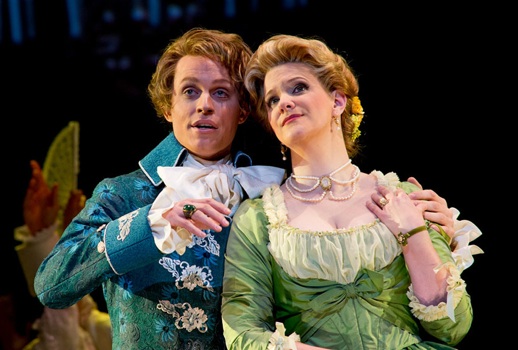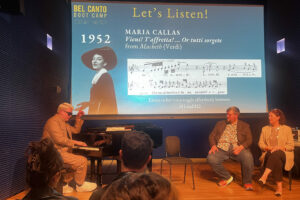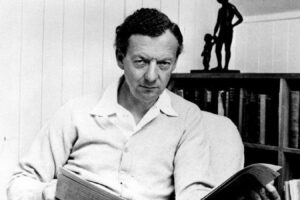

At the time, in my operatic infancy, I remember scoffing at the announcement in Opera News that Corigliano, along with librettist William H. Hoffman, had been commissioned by the Metropolitan Opera and James Levine for the first world premiere in the house since 1967. The premiere was scheduled in honor of the Centennial season for 1983, but that season passed, followed by many others, until the The Ghosts of Versailles finally debuted in 1991. Corigliano labeled it “grand opera buffa” and the Met ran with the grand part, mounting an all-star and physically cavernous production.
A smashing success at its first performances, it was televised and then revived in 1995, with Chicago Lyric presenting it the following year. But a work with over 40 singing roles and a double orchestra can’t travel very far and in 2008 the composer employed the skills of another to reduce the scope for smaller venues. This enabled both its European premiere and a very well regarded production at Opera Theatre of St. Louis. The Met had scheduled another revival for 2010 that came of naught due to budgetary constraints.
The plot concerns the afterlife of the French court of Louis XVI and the playwright Beaumarchais who utilizes his Figaro characters to fashion a divertisment for Marie Antoinette. She’s dead, you know, but the poor dear is still suffering major post-traumatic stress syndrome from the trial and subsequent beheading. It’s a charming conceit that takes on an even larger life of its own when Beaumarchais decides that he’ll rewrite history to stop the revolution and save his beloved queen, who’s referred to as Antonia in the libretto probably for the simple sake that it’s easier to sing and doesn’t end with an unaccented “e.”
As a score it has to be one of the biggest musical in-jokes ever written. Inverted and re-worked, neo-classical, tone clusters from Mozart mesh with bolder quotations from Barbiere, Rosenkavalier, Lohengrin, Schubert and a few others. Although chided by some of the stiffer and stuffier music critics at its premiere for its cheeky reliance on pastiche it’s a work than can make a strong theatrical and music impression in the right hands.
LA Opera has a limping familiarity with modern works and commissions. The success d’estime of Elliot Goldenthal’s Grendel, staged in 2006 by his partner Julie Taymor and starring the relatively unknown at the time Eric Owens, was still fresh in everyone’s mind when they invited the creative team behind the 1986 film remake of The Fly, composer Howard Shore and cirector David Cronenberg—with designer Dante Ferretti along for the ride—to give us their operatic version of that science fiction masterpiece. (Even he reviews weren’t entertaining.)
So the announcement that we were getting a new full-scale production of The Ghosts of Versailles was met by me with not a little musical side-eye and a lot of curiosity. After attending the premiere Saturday night at the Dorothy Chandler Pavillion I am thrilled, and not a little surprised, to say that this production was not only an unqualified triumph but one of the greatest evenings I’ve spent in the theatre.
From the theatrical side the direction by Darko Tresnjak, who’s worked for LA Opera in the past and won a Tony for last years A Gentleman’s Guide to Love and Murder, did a magnificent job of separating, then combining and separating again, the metaphysical planes the drama takes place on so that when Beaumarchais finally decides to enter his own story it becomes shocking to the audience as well as the dramatis personae.

Supremely elegant costumes by Tony winner Linda Cho have half of the “ghosts” in the show dressed in white with black socks over their heads and their “headed” counterparts dressed in identical black. They are all exquisitely turned out and eschewing decay of any kind. The Figaro characters sport bright, gleaming silks and satins to highlight their living presences.
The absolutely superb lighting design by York Kennedy flowed and ebbed with each new scene or musical movement and fantastic digital projections by Aaron Rhyne of an extraordinarily high quality melded seamlessly with the staging. We also had a the occasional circus aerialist and gymnastics by a group called 2 Ring Circus and how all of this coalesced without distraction is a tribute to all concerned.
The large ensemble of singing actors engaged could hardly have been bettered and it’s fitting to start with the first voice you hear, “Woman with Hat” of Victoria Livengood. Scene-stealing would be hardly begins to describe for this lady’s formidable gifts. Entrusted with some of the best punchlines in the piece, both vocal and verbal, she also has the uncanny ability to disappear on stage when necessary to the story and not take attention away from the principlals—until the necessary moment arrives to deliver the comic coup de grace.
The young couple of Florestine and Léon, played by Stacey Tappan and Brenton Ryan, mere youngsters themselves, negotiated their tricky, high-lying, roles (very reminiscent of the Rosenkavalier Sophie and Octavian) with security and aplomb. Robert Brubaker as the villain Bégearss was unstinting in his malevolence and the power with which he rang out over Corilgiano’s massive orchestral forces. If his treachery seemed cartoonish at times it’s only because of the desperate heights his character has to ascend to in order to foil Figaro’s escapades.
Tenor Joshua Guerrero made a wonderful impression as Count Almaviva with a handsome presence and a fervent sound he brought to the last act ensemble, “Oh God of love, O Lord of Light.” His wife Rosina, the Countess Almaviva, was Guangun Yu whose soprano shimmered in all of the sumptuous melodies she’s entrusted with here. Especially lovely was the duet with the delightful Susanna of mezzo Lucy Schaufer, “As summer brings a wistful breeze” in Act II.
The Figaro of Lucas Meachem was explemplary both for his physicality in this very demanding role and his vocalism, which shared equal amounts of gentle restraint and power. His invocation of the stars and constellations in his opening aria, aided and abetted by the production team in most spectacular fashion, was one of the unexpected highlights of the evening.
The finale of the first act takes place in the Turkish Embassy of Paris and it’s a comic and musical free-for-all featuring an Egyptian Singer who is also the lover of the Turkish Ambassador. For this literal “party piece” cameo appearance, the LA Opera had the wit to engage Patti LuPone as the singer Samira. Ms. Lupone was our Widow Begbick in Weill’s Mahagonny back in 2007 and even further back in history the Dorothy Chandler was the first out of town tryout location for Andrew Lloyd Weber’s Evita before it went to Broadway.

And what of our two lovers? Christopher Maltman as Beaumarchais displayed a luxuriant baritone that allowed for easy ascension in this fairly high-lying role. His piano singing was especially full and rich in quality. Patricia Racette was magnificent as Antionette/Antonia, every inch the regal queen. Her voice and diction were superb and her opening scena got the evening off to a proper dramatic start. She’s the kind of singer you really need to see live to enjoy because although her actual vocal quality isn’t particularly exciting she absolutely knows how to put an aria across the footlights and is a riveting stage presence.
James Conlon in the pit showed an absolute mastery of the score and LA Opera Orchestra played like angels for him. Through an evening of very challenging harmonies and swift changes of tempo they alighted on each new melody with precision and a transparency that I hadn’t enjoyed in this work before. (It also appears the composer has tightened up Act II here and there, all to the good.)
A better performance of this large and complex work couldn’t possibly be hoped for and I can’t express strongly enough what a tremendous experience it was to see live. We were “in the presence of the composer’ last night as they say. The Angelenos, notorious for dashing down the aisles to beat everyone else out of the parking structure, stayed and cheered through all the calls and at the final Mr. Corilgano seemed deeply touched. I can only hope this production travels and gets filmed eventually for posterity. In the meantime five more performances remain, so if you miss this once-in-a-lifetime event, you’ll get no pity from me.
Photos: Craig Matthew




























Comments